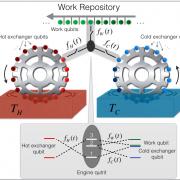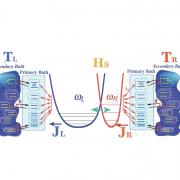Our research focuses on quantum phenomena: Quantum Thermodynamics, Quantum Optimal Control Theory and Quantum Dynamics. In addition we have an applied research effort devoted to public safety.

Quantum thermodynamics is the study of the relations between two independent physical theories: thermodynamics and quantum mechanics. The two independent theories address the physical phenomena of light and matter. It is now possible to manipulate single atoms and ions to enable the construction of heat engines and refrigerators whose cores are comprised of asingle particle. Surprisingly, these microscopic quantum heat machines have been found to obey classical thermodynamical results, which is puzzling. It is expected that quantum eects would modify classical thermodynamics results on the atomic scale. Hence, some of the key outstanding questions in the eld of quantum thermodynamic are: What is quantum about quantum heat machines? We study the relations between the laws of thermodynamics and quantum mechanics.
Quantum Thermodynamics: A dynamical Viewpoint, Entropy 15, 2100 (2013).
Quantum heat engines and refrigerators
A quantum heat engine is a device that generates power from the heat flow between hot and cold reservoirs. The operation mechanism of the engine can be described by the laws of quantum mechanics.

The quantum heat exchanger
The quantum tricycle
Equivalence of Quantum Heat Machines, and Quantum-Thermodynamic Signatures.
Quantum thermodynamics in strong coupling: heat transport and refrigeration.
Quantum Optimal Control Theory
It is control that turns scientic knowledge into useful technology: In physics and engineering it provides a systematic way for driving a system from a given initial state into a desired target state with minimized expenditure of energy and resources. As one of the cornerstones for enabling quantum technologies, optimal quantum control keeps evolving and expanding
Training Schrödinger’s cat: quantum optimal control.
Quantum control with noisy fields
A closed quantum system is dened as completely controllable if an arbitrary unitary transformation can be executed using the available controls. In practice, control elds are a source of unavoidable noise, which has to be suppressed to retain controllability. Can one design control elds such that the eect of noise is negligible on the time-scale of the transformation? This question is intimately related to the fundamental problem of a connection between the computational complexity of the control problem and the sensitivity of the controlled system to noise.
Coherent Control of Binary reactions
We demonstrated coherent control of bond making, a milestone on the way to coherent control of photoinduced bimolecular chemical reactions. In strongeld multiphoton femtosecond photoassociation experiments, we nd the yield of detected magnesium dimer molecules to be controlled.

Ultracold Molecule Formation
We study the control and manipulation of ultracold matter making molecules out of atoms. We demonstrated that judicious shaping of a nanosecond-time-scale frequency chirp can dramatically enhance the formation rate of ultracold 87Rb2 molecules.
Open Quantum Systems: Surrogate Hamiltonian
In reality every quantum systems is open. The interaction with the environment has a profound effect. We construct and study quantum Master equations for molecular systems in condensed phases. As an alternative we are developing the method of stochastic surrogate Hamiltonian which is a wavefunction method for studying the dynamics of open quantum systems. We use the method model solar energy capture and to study quantum refrigerators.

Heat transport and a heat rectifyer.
Solar energy capture
The purpose of computational models is to gain insight. Our goal is to develope quantummodeling methods where the numeical error is under control such that the result depends only on the model. Our mehods are based on a direct solution of the time dependent schrodinger equation and he Liouville von Neumann equation.
Public Safety: Energetic materials
We study the physical chemistry of energetic materials both improvised and military grade. Our purpose is to find ways to remotly detect these materials using spectroscopic methods. The globalization of terror requires that we have to employ our scientic knowledge to develop methods to protect the public. As a result we have initiated studies of improvised explosives such as TATP and military grade such as TNT.






